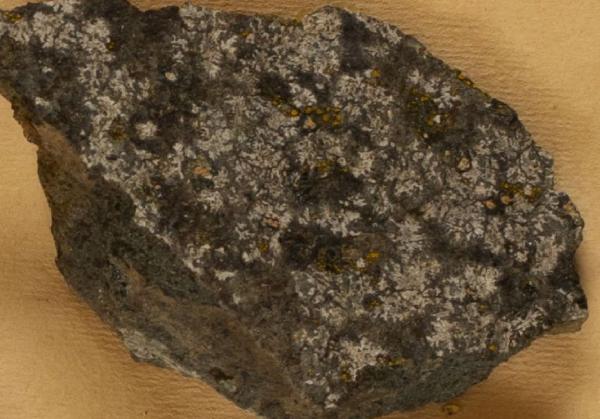Aspicilia verruculosa Kremp.
Denkschr. kgl. bayer. bot. Ges., Abt. 2, 4: 283, 1861.
Synonyms: Aspicilia polychroma var. rubrireagens Asta & Cl. Roux nom. inval.; Oxneriaria verruculosa (Kremp.) S. Y. Kondr. & L. Lőkös
Distribution: N - TAA (Dalla Torre & Sarnthein 1902), Lomb (Nimis & al. 2018), Piem (Nimis & al. 2018).
Description: Thallus crustose, episubstratic, 0.3-0.5 mm thick, areolate-verrucose, whitish grey, grey to blue-grey, grey-pruinose, forming up to 3 cm wide patches, sometimes delimited by a black prothallus. Areoles contiguous, convex, 0.5-1 mm wide, the peripheral ones often darker and elongate, giving the thallus a subplacodioid appearance. Apothecia lecanorine-aspicilioid, immersed in the areoles (1-3 per areole), irregular in outline and sometimes confluent, 0.2-0.4(-0.5) mm across, with a black but thinly white-pruinose, concave to flat disc, and a thick, raised thalline margin. Epithecium brownish green to olive, N+ emerald green; hymenium colourless, 70-80 µm high, I+ blue or I-; paraphyses c. 1.5 µm thick at base, the apical cells to 5 µm wide; hypothecium colourless, 20-30 µm high, not underlain by an algal layer. Asci 8-spored, clavate, the thin outer coat K/I+ blue, the wall and apical dome K/I-. Ascospores 1-celled, hyaline ellipsoid, 12-15(-17) x 7.5-9 µm. Pycnidia immersed, elongated, brown in upper part, with a colourless wall. Conidia thread-like, straight, (14-)16-20 x c. 0.5 µm. Spot tests: cortex and/or medulla K+ yellow or rarely K+ yellow turning red (needle-like crystals), C-, KC-, P+ yellow-orange. Chemistry: stictic acid, rarely norstictic acid.Note: on more or less calciferous rocks in upland areas; closely related to A. polychroma, characterized by the presence of stictic (instead of substictic) acid, more rarely of norstictic acid.
Growth form: Crustose
Substrata: rocks
Photobiont: green algae other than Trentepohlia
Reproductive strategy: mainly sexual
Commonnes-rarity: (info)
Alpine belt: very rare
Subalpine belt: very rare
Oromediterranean belt: absent
Montane belt: absent
Submediterranean belt: absent
Padanian area: absent
Humid submediterranean belt: absent
Humid mediterranean belt: absent
Dry mediterranean belt: absent

Predictive model
Herbarium samples

Bell Museum of Natural History, University of Minnesota - Lichens (MIN:Lichens) - Public Domain
Bell Museum of Natural History, University of Minnesota - Lichens (MIN:Lichens)
Catalog #: 22127
Occurrence ID: af4e646d-a185-465d-9d10-c4c9ce0c8942
Secondary Catalog #: 1357718
Taxon: Aspicilia verruculosa Kremp.
Family: Megasporaceae
Collector: Arnold;
Date: 1897-00-00
Verbatim Date: 1897
Locality: Italy,
Notes: filed at MIN under 'Arnold - Lichenes Exsiccati'\r
Growth form: Crustose
Substrata: rocks
Photobiont: green algae other than Trentepohlia
Reproductive strategy: mainly sexual
Commonnes-rarity: (info)
Alpine belt: very rare
Subalpine belt: very rare
Oromediterranean belt: absent
Montane belt: absent
Submediterranean belt: absent
Padanian area: absent
Humid submediterranean belt: absent
Humid mediterranean belt: absent
Dry mediterranean belt: absent

Predictive model
| Herbarium samples |

 INDEX FUNGORUM
INDEX FUNGORUM
 GBIF
GBIF
 DOLICHENS
DOLICHENS

